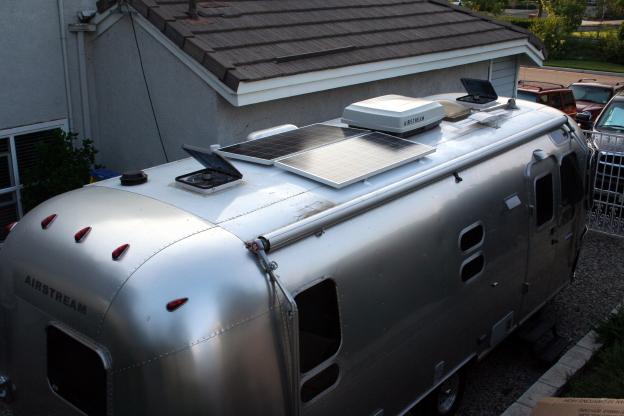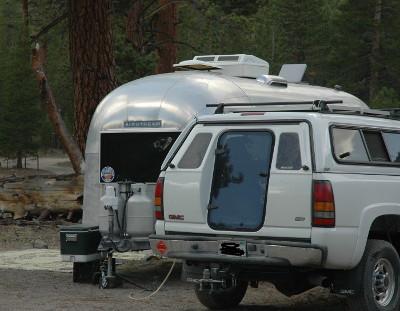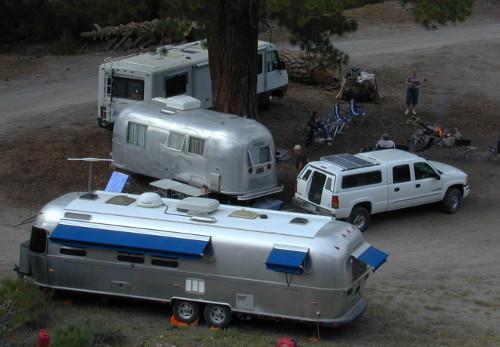Enjoyment of the whispering winds, the zephyrs,
the airstreams of the Sierra Nevada and Great Basin areas of the
United States in a recreational vehicle.
Understanding your solar system
written April 2003
A solar system converts energy from the sun to
electricity you can use in your RV. Since it only provides
electricity when the sun is out, it is usually set up to charge
batteries that can supply electricity when the sun can't.
A solar system has two main components. The solar
panels are outside where they can catch the sun's rays and the charge
controller is an electronic circuit usually stuck inside somewhere to
manage the system.
A solar panel is a lot like a battery in that it
provides electricity at a preferred voltage. A battery depends upon
chemical reactions to make its electricity while a solar panel
depends upon the sun's rays. Batteries tend towards poorer
performance when they get cool while solar panels generally improve
performance when they cool. Batteries have problems keeping up the
voltage when all of their chemicals are converted and solar panels
have the same problem when the sun gets weak. Batteries are composed
of 2 volt cells and most RV batteries use six cells for about twelve
volts. Solar panel cells are about a half a volt each and panels use
36 cells to provide about 18 volts. The reason solar panels are at a
higher voltage than batteries is so they can push electricity into a
battery to charge it.
The charge controller's main job is to connect the
solar panel to the battery when (a) the battery needs charging and
(b) the panel is able to generate enough energy to do the charging.
There are other management tasks a charge controller can do as well.
Solar panels should be disconnected when they are not producing
electricity. Batteries need to be charged properly for fastest
possible recovery and long life. Users need to be informed about the
status of their solar system and its components. Modern charge
controllers use built in computers and power supply technology to
make the most of the energy from the solar panel.
As of 2017 Solar panels are becoming almost
standard equipment on most RV’s. Roof mounted are the most common.
Here are three examples of RV solar panels.
Click on image for larger view

|
|

|
|

|
|

|
|
A portable solar panel offers a lot of flexibility. It can be
moved to follow the sun and it enables you to park your trailer in
a shaded spot without the worry of shading the panel.
|
|
Solar panels mounted on the roof of the trailer don’t require
any set up but it means that in order to be most effective, the
trailer needs to be parked where it will get the most sun.
|
|
The solar panel is barely visible on the top of the truck. Again,
the truck can be moved with the sun while the trailer stays
stationary.
|
|
A view of the solar panels on the top of the truck
|
|
How much do you need?
If you look in the store for battery chargers, you
will find most of them run around ten amps. This is about the minimum
needed to charge a typical RV or automotive battery in a reasonable
time. A ten amp solar panel is about a hundred watts. Less than this
and you aren't doing any effective battery charging. More than this
means you can charge more batteries or charge them fast enough so
they are brought up to full charge in only a day or so of full
sunlight.
The maximum amount of power you can get from the
sun is about a kilowatt per square meter. If we allow about 17% loss
for haze, angle of the sun and other factors, we'd have a kilowatt
per square yard or about 100 watts per square foot. But solar panels
are only 15% efficient in the best case so you'd need to increase
solar panel size by seven or eight times to compensate for the poor
efficiency. What all this means is that you will need almost a square
yard of solar panels to get 100 watts from your panels on a sunny
day. You might have 6 square yards on the roof of a typical larger RV
but working around vents, air conditioners, antennae, or other things
makes filling the entire roof with panels impractical.
The charge controller
The charge controller is the brains of your
system. At its simplest level it is answering the question: "should
the panel be connected to the battery or not?" To figure out the
answer, the controller needs to determine if the solar panel is
producing enough energy to move it to the battery instead of vice
versa and that the battery is in a condition to accept the energy.
The simplest charge controllers take a look at the panel output and
battery voltages and then either connect or disconnect. These are
shunt type controllers.
PWM or pulse width modulation controllers
incorporate modern technology to improve battery charging. They
control the current going to the battery in order to charge the
battery more fully and faster.
MPPT or maximum power point tracking controllers
work like PWM on the battery side and also use a similar technology
on the solar panel input side. This means they are not only smart
about charging batteries but also smart in how to pull the most power
from the solar panel. MPPT controllers work best when the voltage
difference between the solar cell and the battery is largest. This
happens when the battery is discharged and the solar panel is cool.
Wiring
The wiring can make or break your solar system.
With most RV solar systems, the current is only ten or twenty amps
and the run is only ten or twenty feet so super heavy cable isn't
usually necessary – just somewhat heavy cable such as between 6 and
10 gage. Wires that are outside, such as the wires connecting the
panels, need to have an insulation that can withstand the elements.
All wires need to be tied down so they don't flap and chafe.
Connections need to be properly secured so they don't come loose.
Monitoring
The basic information you need to determine how
your system is doing is battery voltage under a light load. Some of
the low end systems just use a set of indicator lights to tell you if
you are low, OK, or high. Better systems actually tell you the
voltage. More advanced systems allow you to see the voltage and
current being produced by the solar panels. High end systems keep
track of current use and can provide a battery capacity remaining
indication.
Resources
Sierra
Nevada Airstreams home page
-|- Destinations
-|- Memories
-|- Owner's
Guide
-|- WBCCI
Sierra Nevada Unit home page
-|- Community
-|- Zephyrs
weblog for the RV enthusiast
-|- Commerce
-|- Whispers
weblog of touchy subjects
-|- Our tip jar- support this website

TechComm
Labs (tm)
|
|
supporting and using open software
|
|
|

|
note:
all photographs on this site are for personal, private, and
non-commercial use only. All other copyrights are retained by the
individual photographers. See our
policy. Disclaimer:
any advice or suggestion presented is provided for informational
purposes only and is correct and accurate only to the best of our
knowledge at the time it was written. Anyone using such information
does so at their own risk. Errors or omissions may exist and
additional sources of information or appropriately licensed or
qualified personnel should be consulted in deciding a course of
action. We assume no liability or obligation by providing this
information and warn any users of this information that they do so at
their own risk. All links or references to commercial vendors or
other sources of information and equipment do not intend or imply or
convey any endorsement of that source or the product. They are
provided strictly for informational purposes to illustrate the topic
at hand. Sierra Nevada
Airstreams Enjoyment
of the whispering winds, the zephyrs, the airstreams of the Sierra
Nevada and Great Basin areas of the United States is a
personal, nonprofit,
noncommercial web site intended for educational and recreational use
only. This site is supported by volunteer effort and contributions.



